Key takeaways:
- Vintage toys foster imagination and creativity, providing unique sensory experiences that modern toys often lack.
- Traditional playthings have evolved from handcrafted items to mass-produced toys, reflecting cultural values and allowing children to explore their worlds.
- Engaging with vintage toys enhances social skills and relationships, promoting shared experiences over solitary play typical of modern toys.
- Restoration of vintage toys preserves memories and stories, requiring a balance between maintaining original charm and revitalizing their spirit.

Understanding vintage toys
Understanding vintage toys goes beyond their nostalgic appeal; it’s about recognizing their role in shaping childhood experiences. I remember spending hours with my clunky, tin robot, imagining grand adventures in outer space. It wasn’t just a toy; it was a gateway to my imagination, much like it was for countless children before me.
These toys often reflect the values and creativity of the time in which they were made. When I peek at a beautifully crafted wooden train or a plush teddy bear from decades past, I can’t help but wonder: what stories do they carry? Each scratch and scuff tells a tale of laughter, friendship, and sometimes even tears.
Moreover, vintage toys invite us to reflect on a simpler time when play meant unplugging from the digital world and engaging with the tangible. Can you recall the unique smell of plastic or the satisfying sound of the wind-up mechanism? It’s a sensory experience that modern toys often miss. In embracing these traditional playthings, we connect with a legacy of creativity and joy that is worth celebrating.
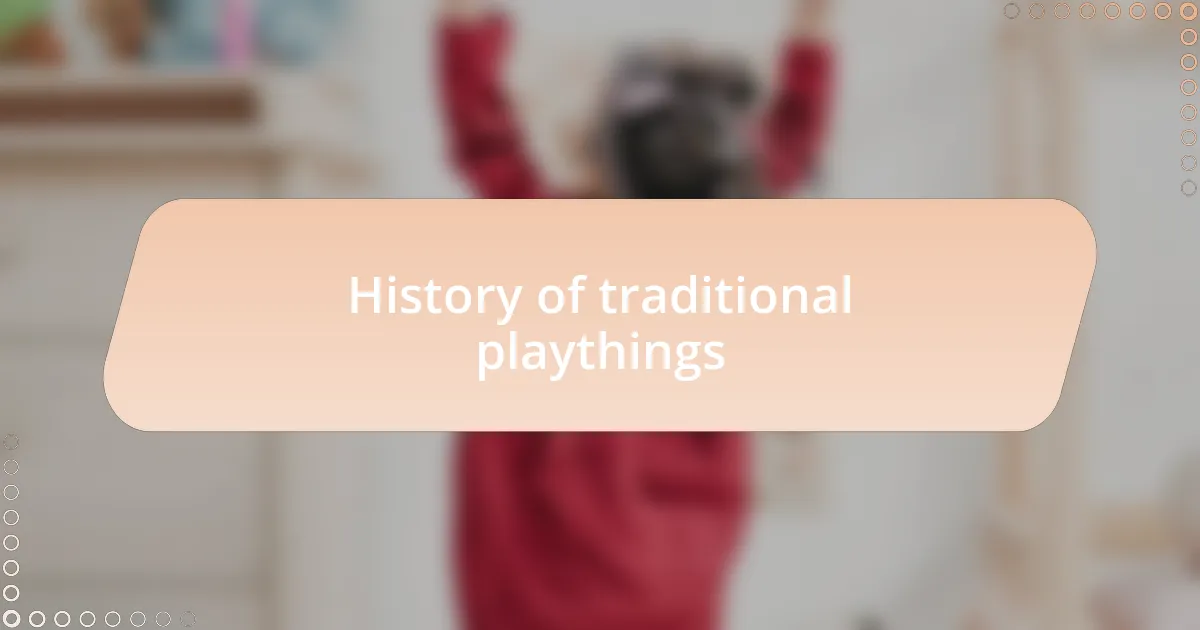
History of traditional playthings
Traditional playthings have a rich history that traces back centuries, evolving from simple handcrafted items to mass-produced treasures. I often think about the charm of those first handmade toys, like dolls crafted from cloth and straw or wooden building blocks, which sparked creativity in young minds long before the age of plastic. It’s fascinating to realize how these simple objects allowed children to explore their worlds through imaginative play.
In the early 20th century, the rise of industrialization brought a transformation in toy manufacturing. I remember hearing stories from my grandparents about how they played with tin toys and marbles, which represented a leap in creativity and accessibility. These toys not only entertained but also provided children a sense of belonging and a means of social interaction that is still cherished today.
As I reflect on my own childhood with classics like cap guns and jigsaw puzzles, I see how traditional toys fostered connections among friends. Have you ever noticed how playing together with a board game or sharing a well-loved stuffed animal creates bonds that last a lifetime? It’s incredible how these historic playthings transcend time, continuing to influence how children learn and socialize, even in the age of screens.
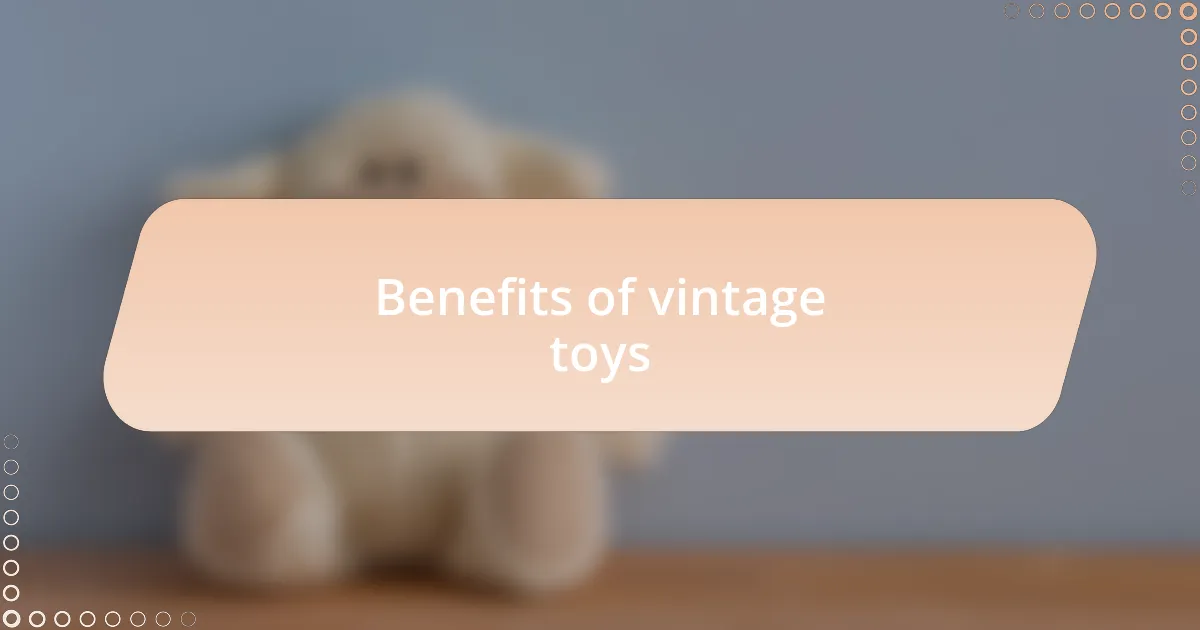
Benefits of vintage toys
There’s something inherently special about vintage toys that goes beyond mere fun. In my experience, they often spark nostalgia, reminding us of simpler times when play was about imagination and creativity. I vividly remember spending afternoons with a wooden train set that challenged my engineering skills, laying tracks and creating entire worlds. Have you ever felt how a toy can inspire innovation in a child’s mind?
Another remarkable benefit is the durability of many vintage toys. Unlike today’s often flimsy counterparts, these toys were built to last. I still have a toy soldier from my childhood that’s been through countless battles, and it’s a testament to the craftsmanship of that era. Isn’t it reassuring to know that as kids, we had toys that could endure, not just physically but also emotionally, as they became cherished keepsakes?
Engaging with vintage toys also fosters invaluable social skills. I recall gathering around a classic board game with friends, where laughter echoed as we strategized our next move. These moments not only taught teamwork but also nurtured communication. Doesn’t it feel different when children interact with tangible toys, as opposed to a screen? There’s a unique connection formed through shared experiences, one that digital play often lacks.
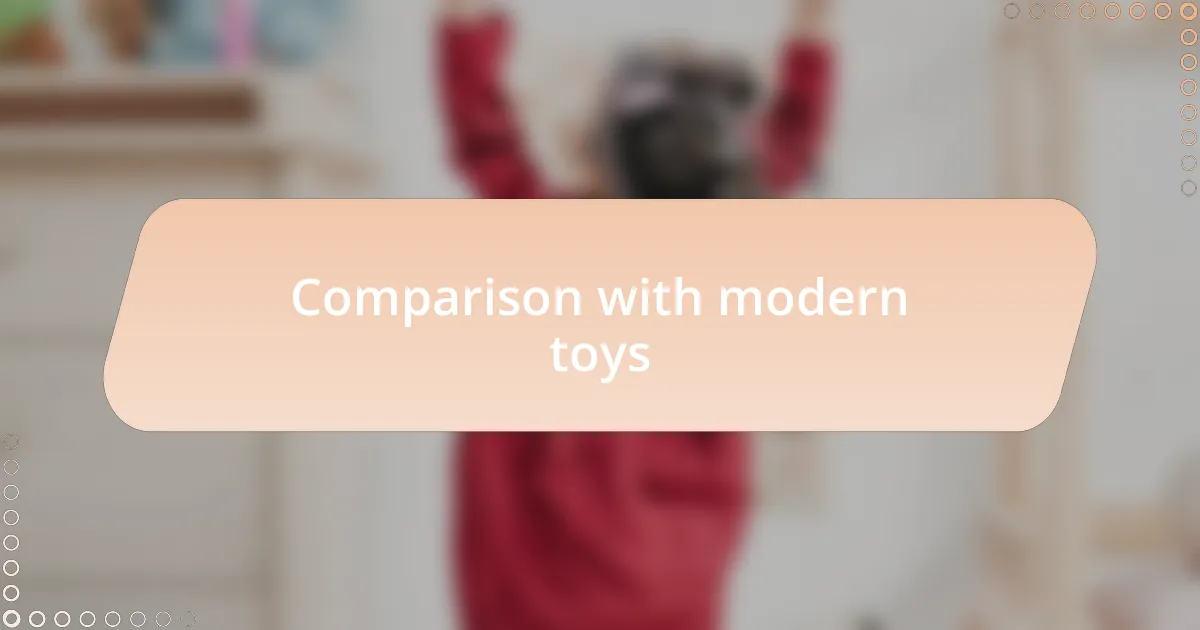
Comparison with modern toys
Modern toys certainly have their appeal, often dazzling with the latest technology and flashy designs. However, as I playfully compare them with vintage toys, I can’t help but appreciate the simplicity and creativity found in the older options. For instance, when I watch a child engrossed in a beautifully crafted wooden dollhouse, I see a depth of imaginative play that sometimes seems to fade with the beeping gizmos of today. Isn’t it fascinating how basic shapes and colors can stimulate a child’s creativity more than a screen ever could?
In my experience, there’s also a stark contrast in how long each type of toy can hold a child’s attention. While modern toys may capture interest quickly, they often fall short in sustaining it. I remember my sister and I spending days transforming our backyard into a world of adventure with simple action figures, using just our minds to fuel the stories we created. Doesn’t that kind of transformative play, where children become the architects of their fun, feel more impactful than following a pre-set digital game routine?
Additionally, I find that vintage toys tend to foster deeper connections—not just with the child’s imagination, but with family and friends as well. Imagine gathering around a simple puzzle or a classic card game, where conversations flow and laughter reigns. That communal experience, I believe, is often missing in the solitary play that can accompany modern toys. So, which type of play do you think nurtures bonding more effectively: the shared joy of vintage playthings or the isolated experiences of today’s tech-driven options?
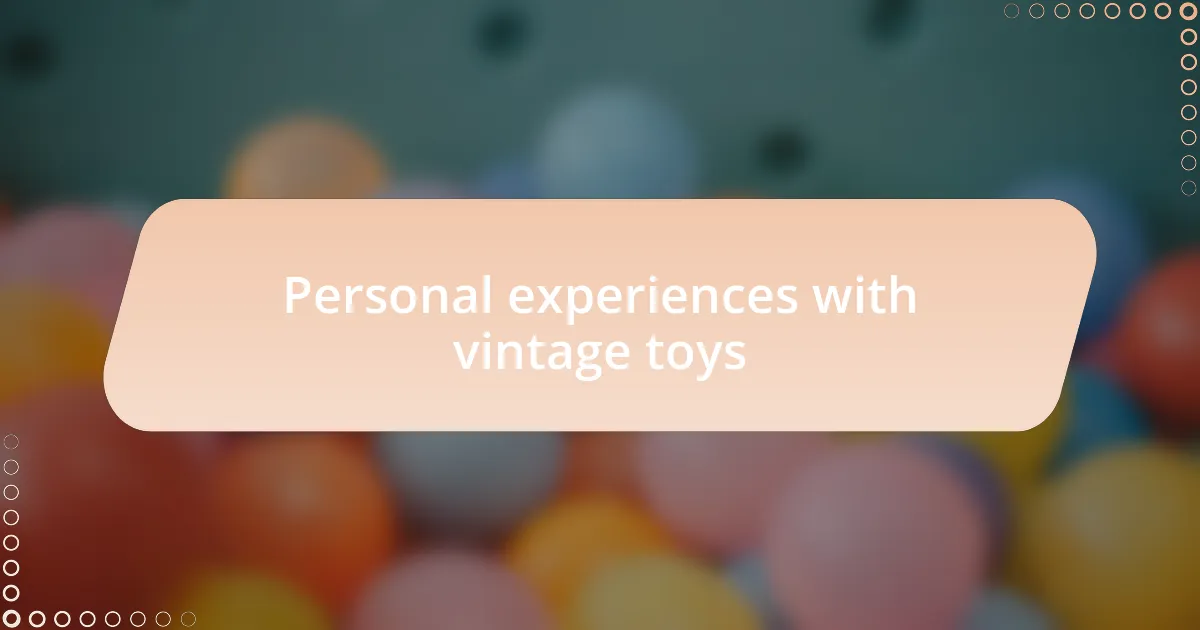
Personal experiences with vintage toys
When I look back on my childhood, there’s a vivid memory of my brother and me playing for hours with a vintage train set. It was a simple loop of track, but every curve and connection opened a new world of stories. I can still hear the sound of that little engine chugging along, taking us on adventures that only our imaginations could define. Isn’t it incredible how a few pieces of metal and wood could spark such joy and creativity?
One of my favorite vintage toys was a colorful set of building blocks that my parents had saved from their own childhood. I remember the thrill of stacking them higher and higher, the suspense building with each precarious layer. Whenever they toppled over, instead of frustration, I found laughter igniting a new game. Wasn’t that delightful unpredictability part of the charm? It’s moments like these that I believe showcase the essence of play—learning through trial, error, and heaps of fun.
Over the years, I’ve noticed that vintage toys seem to carry a sense of nostalgia. Each time I see a classic teddy bear or a well-loved board game, it brings back waves of fond memories. I recall holiday evenings spent with family, gathered around those games, where the stakes were high but smiles were higher. Could anything in today’s world replicate that feeling of closeness as we cheered, groaned, and laughed over a shared sense of play?
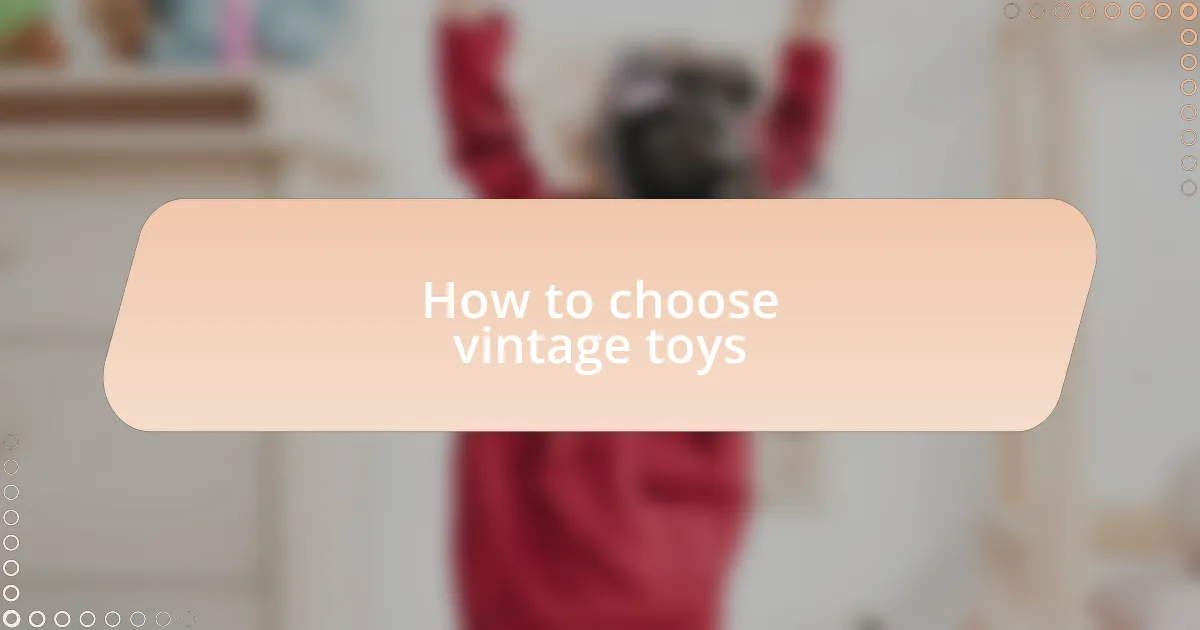
How to choose vintage toys
Choosing vintage toys requires a little know-how and a lot of heart. I always look for pieces that not only resonate with my own childhood memories but also spark joy in younger generations. For instance, when I stumbled upon an old wind-up toy at a flea market, I could immediately envision my friends’ eyes lighting up with excitement. That excitement is a key indicator of a vintage toy’s potential.
It’s equally important to assess the condition of the toy. I recall finding a beautiful, albeit slightly worn, wooden puzzle. It had a charming patina—like a well-loved book with dog-eared pages. While it’s essential that toys are safe for play, the signs of age can also add character, telling a story of their own. What’s more appealing than a toy that’s been part of countless imaginative adventures?
Always consider the origin of the toy as well. When I choose vintage toys, I love discovering the history behind them. For instance, I once came across a tin toy from the 1950s that had once belonged to a child in a different era. The thought of that child’s laughter and playfulness gives me a warm sense of connection. Isn’t it fascinating to think about the experiences that have shaped these toys over the years? Each piece is a bridge to the past, inviting new memories to be created.
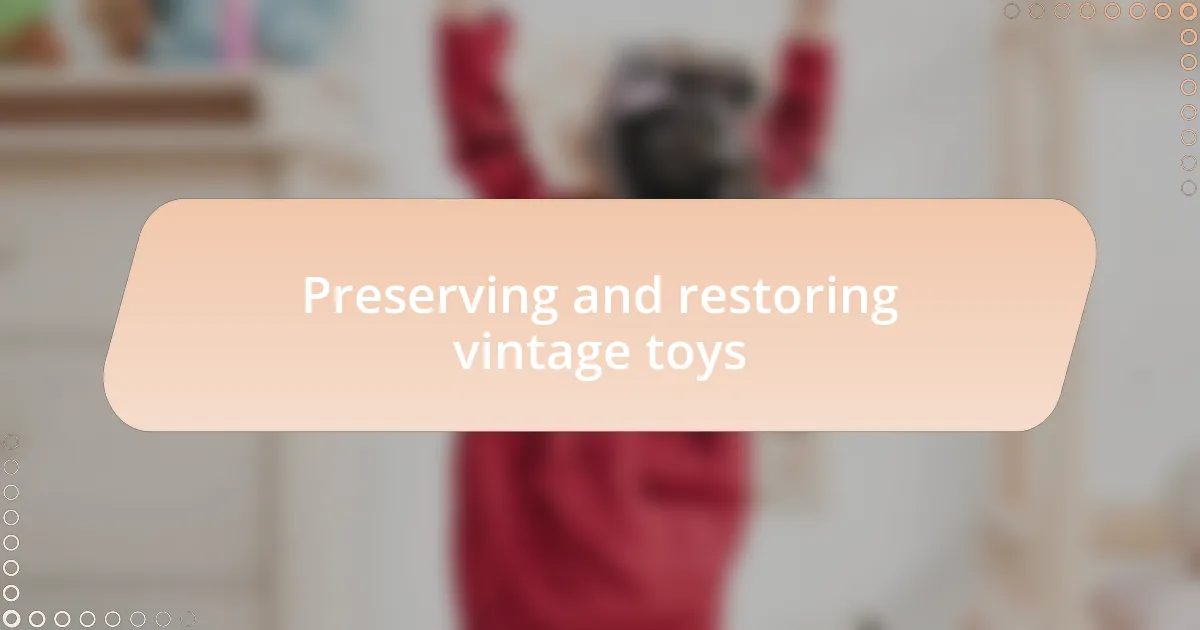
Preserving and restoring vintage toys
Restoring vintage toys is more than just a hobby; it’s a heartfelt commitment to preserving memories. I remember spending countless weekends meticulously cleaning a rusty metal car from the 1960s. The process was tedious but rewarding, as each scrub revealed vibrant colors beneath layers of grime, breathing new life into what once seemed like a forgotten relic. Doesn’t it feel fantastic to turn back the clock, even if just for a moment?
Sometimes, the simplest repairs can make the biggest difference. I once found an old stuffed bear with a missing button eye. After a bit of sewing and a trip to the craft store for a perfect match, the bear was restored to its former glory. This experience taught me that even small changes can revitalize a toy’s spirit and allow for new generations to cherish them. Isn’t it interesting how a single detail can reawaken an entire story?
It’s essential to remember that restoration should maintain the toy’s original charm. I’ve encountered vintage dolls that, despite their worn faces, held stories in their painted features. When I gently refurbished one, I chose to enhance its character while staying true to its history. This balance between restoration and preservation is crucial—after all, each scratch and faded spot carries a piece of the past that deserves respect. How do you feel about finding the right balance when restoring vintage treasures?